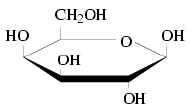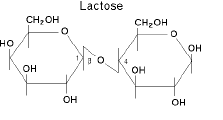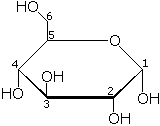Galactosemia
| Galactosemia Classification and external resources | |
| Galactose | |
| ICD-10 | E74.2 |
| ICD-9 | 271.1 |
| eMedicine | ped/818 |
| MeSH | D005693 |
Galactosemia is a rare genetic metabolic disorder that affects an individual's ability to properly metabolize the sugar galactose. Goppert first described the disease in 1917 (Goppert 1917), with its cause as a defect in galactose metabolism being identified by a group led by Herman Kalckar in 1956 (Isselbacher et al. 1956). Incidence of the most common or classic type of galactosemia is about one per 62,000 births (Merck).
Cause
Normally, lactose in food (such as dairy products) is broken down by the body into glucose and galactose, and these sugars are further metabolized. In individuals with galactosemia, the enzymes needed for further metabolism of galactose are severely diminished or missing entirely, leading to the build up of toxic levels of galactose in the blood, resulting in hepatomegaly (an enlarged liver), cirrhosis, renal failure, cataracts, and brain damage. Without treatment, mortality in infants with galactosemia is about 75 percent.
The fourth carbon on galactose has an axial hydroxyl (-OH) group. This causes galactose to favor the open form as it is more stable than the closed form. This leaves an aldehyde (O=CH-) group available to react with nucleophiles, particularly proteins which contain amino (-NH2) groups, in the body. This uncontrolled reactivity gives way to glycolation. Glycolation causes disease by altering the structure of proteins in ways that were not intended for biochemical processes.
Diagnosis and Treatment
Infants are now routinely screened for galactosemia in the United States, and the diagnosis is made while the person is still an infant.
The only treatment for classic galactosemia is eliminating lactose and galactose from the diet. Even with an early diagnosis and a restricted diet, however, some individuals with galactosemia experience long-term complications.
Galactosemia is sometimes confused with lactose intolerance, but galactosemia is a more serious condition. Lactose intolerant individuals have an acquired or inherited shortage of the enzyme lactase, and experience abdominal pains after ingesting dairy products, but no long-term effects. In contrast, galactosemic individuals who consume galactose can cause permanent damage to their bodies.
Types
Galactose-1-phosphate uridylyltransferase galactosemia (or Galactosemia type 1) is the most common and classic type of galactosemia. It is caused by a deficiency in galactose-1-phosphate uridylyltransferase. Galactose 1-phosphate uridylyltransferase galactosemia is characterized by poor growth in children, mental retardation, speech abnormality, vision impairment (due to formation of cataract) and liver enlargement (which may be fatal). Strict removal of galactose from diet is required.
UDPgalactose-4-epimerase deficiency involves the enzyme UDPgalactose-4-epimerase. It is extremely rare, with only two reported cases. It causes nerve deafness.
ReferencesISBN links support NWE through referral fees
- Goppert, F. 1917. Galaktosurie nach Milchzuckergabe bei angeborenem, familiaerem chronischem Leberleiden. Klin Wschr 54:473-477.
- Isselbacher, K. J., E. P. Anderson, K. Kurahashi, and H. M. Kalckar. 1956. Congenital galactosemia, a single enzymatic block in galactose metabolism Science 13(123): 635-6. Retrieved May 11, 2008.
- Merck. Carbohydrate metabolism disorders—Galactosemia Retrieved August 8, 2008.
External Links
- Genetics Home Reference. Galactosemia Retrieved August 8, 2008.
Credits
New World Encyclopedia writers and editors rewrote and completed the Wikipedia article in accordance with New World Encyclopedia standards. This article abides by terms of the Creative Commons CC-by-sa 3.0 License (CC-by-sa), which may be used and disseminated with proper attribution. Credit is due under the terms of this license that can reference both the New World Encyclopedia contributors and the selfless volunteer contributors of the Wikimedia Foundation. To cite this article click here for a list of acceptable citing formats.The history of earlier contributions by wikipedians is accessible to researchers here:
The history of this article since it was imported to New World Encyclopedia:
Note: Some restrictions may apply to use of individual images which are separately licensed.


